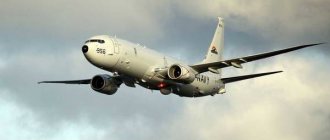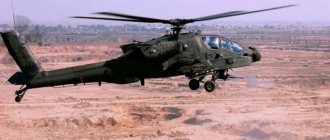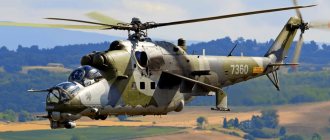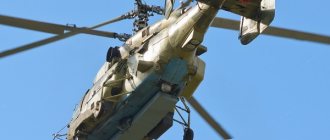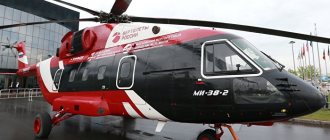In 2022, the ground forces, airborne forces and coastal forces will receive more than a thousand units of equipment. During a speech at an extended meeting of the board of the Ministry of Defense, the head of the defense department, Sergei Shoigu, noted that the military will receive launchers with intercontinental ballistic missiles (ICBMs), strategic missile carriers, new air defense systems and a nuclear submarine cruiser. In turn, 257 aircraft will be transferred to the Aerospace Forces. Some types of equipment and weapons will be supplied to the troops for the first time in 2022, and a number of promising developments will be closer to being put into service. About helicopters, rockets, airplanes and other new products - in the material of Lenta.ru.
Hypersonic anti-ship cruise missile "Zircon"
Serial deliveries of Zircon hypersonic missiles will begin in 2022
Frame: Press service of the Ministry of Defense of the Russian Federation
On December 24, Russian President Vladimir Putin announced the successful salvo launch of Zircon missiles. This event marked a milestone in the multi-year development and testing of the hypersonic missile. Shortly before this, Sergei Shoigu spoke about serial deliveries of the rocket in 2022.
As part of the tests, the missile was launched from the submarine Severodvinsk and from the frigate Admiral of the Fleet of the Soviet Union Gorshkov.
Future Vertical Lift Program
From October 14 to 16, the AUSA (Association of the United States Army) exhibition of military equipment and weapons was held at the Washington Convention Center.
The exhibits presented there will tell little about anything to a person who is not interested in military equipment: in appearance, these are ordinary models, concepts and “pictures”. In fact, not only multi-billion dollar contracts are at stake, but also the direction of evolution of helicopter technology. However, first things first. The end of the Cold War and the development of UAVs slowed the development of new attack helicopters. The Boeing/Sikorsky RAH-66 Comanche program was closed back in 2004, having, by the way, spent a fantastic amount on it - more than eight billion dollars. As a result, the Ground Forces were left with proven, but frankly old vehicles, even if they had gone through more than one stage of modernization. The main workhorse of the US Army - the multi-role Sikorsky UH-60 Black Hawk - began to be produced back in 1977, when the Huey began to age. In turn, the basis of the strike “winged cavalry” - the AH-64 Apache - first took to the skies back in 1975. Well, the heavy transport Chinook even survived the Vietnam War: it actually comes from the 60s. The worst situation is with light reconnaissance helicopters. Let us remind you that the US “veteran” Bell OH-58 Kiowa has already been taken out of service, and its functions have been partially taken over by Apache.
Purely hypothetically, even now it is possible to leave everything as it is, making do with the modernization of existing helicopters, despite their advanced age. However, in the United States they decided differently, launching a large-scale Future Vertical Lift (FVL) program in the 2000s, designed to create a whole line of new rotorcraft. They should replace almost all other helicopters - from Kiowa to Chinook and even some of the C-130J Super Hercules military transport aircraft.
It looks like this:
- JMR-Light: replacement for the light OH-58 Kiowa;
- JMR-Medium-Light: intermediate option;
- JMR-Medium: replacement for UH-60 Black Hawk and AH-64 Apache;
- JMR-Heavy: replacement for CH-47 Chinook;
- JMR-Ultra: a very large and load-lifting vehicle of a fundamentally new class with vertical take-off and landing.
As you probably already guessed, we will talk about the JMR-Light, which is also known as FARA (Future Attack Reconnaissance Aircraft). Don't let the word "light" or "reconnaissance" confuse you. The new helicopter will be only a conditional successor to the simple OH-58: in fact, it will be a completely different device with new capabilities, which will be conceptually closer to the unrealized Comanche than to any other US helicopter.
Why did the Americans need such a “wunderwaffe”? The reason lies in the strengthening of the PRC, as well as the Russian factor. The new machines are designed to ensure the absolute technological leadership of the United States in the helicopter industry for many decades to come. The US Department of Defense concluded design contracts under FARA in 2019.
There are five manufacturers in total:
- AVX Aircraft (in partnership with L3Harris Technologies);
- Bell Helicopter;
- Boeing;
- Karem Aircraft;
- Sikorsky Aircraft.
From this number, two will be selected to build prototypes in the 2020s. By the end of the next decade, a winner should be determined, who will produce a serial helicopter. Now let's see what exactly they offer as part of Future Attack Reconnaissance Aircraft.
Let's make a reservation. The appearance and characteristics of machines (even within the framework of one specific project) may change more than once during the process of being brought to mass production. The best example is Raider-X.
Strategic missile system RS-28 "Sarmat"
Tests of the Sarmat ballistic missile
Frame: Press service of the Ministry of Defense of the Russian Federation
At an extended meeting of the board of the Ministry of Defense, Sergei Shoigu announced that in 2022, the arsenal of the Strategic Missile Forces (RVSN) will be replenished with 21 launchers with intercontinental ballistic missiles (ICBMs). Speaking about new products, the Minister of Defense mentioned the Sarmat complex, which is being tested.
Earlier, the commander of the Strategic Missile Forces, Colonel General Sergei Karakaev, said that the first regiment armed with the Sarmat ICBM would go on combat duty in 2022. The Uzhur missile formation will receive new weapons.
It is believed that the RS-28 can deliver a warhead weighing up to 10 tons to anywhere in the world. The promising silo-based strategic missile system will replace the R-36M2 Voevoda missiles.
Anti-aircraft missile system "Gibka-S"
Anti-aircraft missile system "Gibka-S"
Photo: JSC NPO High-Precision Complexes
In 2022, air defense units will receive platoon sets of Gibka-S anti-aircraft missile systems (SAM) for the first time. The head of the military air defense of the Russian Armed Forces, Lieutenant General Alexander Leonov, noted that the new air defense system received reconnaissance equipment and an automatic control system. This allows the military to maintain round-the-clock watch and control fire in real time.
Also, Gibka-S became the first Russian self-propelled short- and ultra-short-range complex of the VSHORAD (Very Short-Range Air Defense) type. The air defense system can hit airplanes, helicopters, drones and cruise missiles that fly at a minimum altitude. "Gibka-S" uses ammunition from man-portable anti-aircraft missile systems (MANPADS) "Igla", "Igla-S" and "Verba".
Ka-52M reconnaissance and attack helicopter
Photo: Konstantin Mikhalchevsky / RIA Novosti
During the international military-technical forum Army 2021, which was held in August, the Ministry of Defense and the Russian Helicopters holding company signed a contract for the supply of modernized Ka-52M helicopters. As part of the agreement, the military will receive 30 reconnaissance and attack vehicles. Later, a source in the aircraft industry said that helicopter deliveries would begin in 2022.
The Ka-52M received a modernized optical-electronic system and a new radar complex with an active phased array antenna (AFAR). Also, the modernized helicopter will be able to carry new weapons, including Ataka, Vikhr and Vikhr-M missiles.
Mi-28N Night Hunter
The Russian army has one of the best, and perhaps the best, selection of combat helicopters capable of carrying out the most serious missions. Perhaps the most famous Soviet combat helicopter was the Mi-24, developed back in the 70s of the last century. However, time does not stand still and already in the 80s the development of a more modern attack vehicle based on the Mi-24 began, especially since the 24 is not a purely attack helicopter, but it was also used as a landing helicopter. The Mi-28 prototype made its first flight in 1982, but the project was greatly delayed and the first prototype of the updated Mi-28N was shown to the general public only 14 years later. Despite the difficult situation in the country, the company’s team was able to bring the combat vehicle to completion, but the military simply did not have the money to update the helicopter fleet. The first government order was received only in 2005, and then the purchase of 67 machines was extended over 7 years and all this time it was being refined and improved. The Mi-28N was adopted by the Ministry of Defense on December 27, 2013. Currently, the Russian Air Force has about 90 Mi-28s and plans to continue updating its fleet of attack helicopters.
Loitering ammunition KUB-BLA
Loitering ammunition KUB-BLA
Personnel: JSC Concern Kalashnikov
In 2022, the Russian military will receive a new type of weapon. On December 17, the press service of the ZALA Aero company (part of the group) announced the successful completion of state tests of the KUB-BLA drone. The device was recommended for adoption, and deliveries could begin in 2022.
KUB-UAV received an electric motor, which provides a maximum speed of up to 130 kilometers per hour. The ammunition can stay in the air for up to 30 minutes, and the mass of the warhead is 3 kilograms.
What will be the successors of the Alligator or the new combat helicopter of the future under the Kamov brand?
Home » Helicopters » What will be the successors of the Alligator or the new combat helicopter of the future under the Kamov brand
HelicoptersWeapons of the future
boroda 11/26/2019 1625
14
in Favoritesin Favoritesfrom Favorites 5
In the Soviet Union there was total secrecy and a company of spy mania. No new military developments were reported anywhere. No one knew what the engineers of our design bureaus were working on. Not only the characteristics of promising models of equipment, but also their name and even appearance were unknown. Because of this, the West had to come up with what the military equipment of the USSR of the future would look like (this is well written in the series of articles Shadow Fighting ).
This is, of course, an extreme; it would be useful for people to know that they are under reliable protection and it is not in vain that our defense industry eats the people’s bread. But now everyone has gone to the other extreme, to every exhibition, to every military forum, it has become customary to bring at least some model, with varying degrees of futurism. It seems that the model departments of our design bureaus, which today have become concerns, joint-stock companies and holdings, are the most actively working departments of design bureaus.
Relatively recently, Kamov JSC presented a very extraordinary helicopter model called Ka-90 . The model looked very futuristic, as can be seen in the photo below:
After the Ka-90 was shown, information about it disappeared from our press. No one knows what his fate is. There is no information about testing or the construction of at least one sample. However, instead of bringing to life the previously shown example of technology, Kamov presents another model.
This time the authors did not bother to make even a normal model; it is presented only in the form of 3D graphics. True, this model was presented by none other than general designer Sergei Mikheev. The future car does not have a model, or even a name, but the authors of the project freely discuss its future characteristics.
According to Mikheev, a helicopter built according to this design will be able to reach a maximum speed of 500 km/h and even more. We are talking about a speed range from 500 to 700 km/h.
The general designer of JSC Kamov cited as an example the testing of the high-speed experimental helicopter S-97 :
Americans believe they can reach speeds of 500 km/h. “But you won’t be able to reach higher speeds because it will fall apart due to the load. Therefore, in order to further increase speed, we need to switch to a tiltrotor design,” said the Russian aircraft designer.
Further, Sergei Mikheev noted that the American S-97 does not have a wing that would create lift at high speeds and unload the main rotor:
“The wing at high speed begins to unload the main rotor. However, this also has its own nuances - the wing has quite a lot of weight and you have to sacrifice either combat or commercial load. As you know, transition modes are the most difficult for a tiltrotor. I don’t know whether the authors of this sketch want to stop the rotors. Hardly. I think simply as the flight speed increases, reduce the speed of their rotation, so that the flow speed at the end of the advancing blade is not close to the speed of sound. We are also considering the issue of controlling the speed of rotation of the main rotor, which involves reducing its speed in cruising flight at high speed... I have already said that, for example, we are considering the issue of controlling the speed of the main rotor: at the stages of vertical take-off they should be maximum, providing the greatest lifting force, and when flying at high speed, in order to prevent the advancing blade from entering the transonic flow regime, they need to be reduced...”
The sketches presented during the speech by the general designer of Kamov are striking in their unusualness, and many noted that they depict a combat vehicle combining a helicopter and an airplane. Disputes have also flared up about why it is necessary to accelerate helicopters as such: an increase in maximum speed of only 200-300 km/h in this area essentially requires a revolution in helicopter manufacturing. The argument in favor is the prospect of a vertical take-off replacement for subsonic attack aircraft that require a runway.
Source - https://tehnoomsk.ru/node/3439
Robotic complex "Uran-9"
Robotic complex "Uran-9"
Photo: Press service of the Russian Ministry of Defense
Also, 2022 will be another step in the full operation of robotic systems. In October, Commander-in-Chief of the Ground Forces, Army General Oleg Salyukov, announced that trial military operation of Uran-9 combat robots was planned for 2022. After this stage, the military will determine the number of robotic systems to be purchased.
In 2022, Uran-9 was successfully used at the joint strategic exercises between Russia and Belarus “Zapad-2021”. The robots successfully hit armored vehicles of a mock enemy at a distance of up to five thousand meters.
Fifth generation fighter Su-57
In 2022, troops of the Eastern Military District will receive the first Su-57 fighters
Photo: Anna Zvereva / Flickr
In 2022, the first multirole fighters of the fifth generation Su-57 will be received by the troops of the Eastern Military District (VVO). The commander of the Eastern Military District, Colonel General Alexander Chaiko, announced this during the final board meeting of the Russian Ministry of Defense.
The fifth generation fighter Su-57 is designed to destroy all types of ground, air and surface targets. The aircraft received a radio-absorbing coating and weapon compartments inside the fuselage, which makes the Su-57 stealth. The first production aircraft was handed over to the Russian Aerospace Forces in December 2022.
Mi-38 helicopter
The Mi-38 is a worthy successor to our most famous Soviet-era helicopter, the M-8, and its direct successor. The development of a more modern helicopter of this class has been going on for a long time, but the first was the Mi-171, which is essentially another deep modernization of the Mi-8. The first news about a completely new model appeared in the news in 2013, when it set several records during the testing phase.
Read The most powerful weapon of Russia
At present, serial production has not yet begun and only 4 flying copies have been produced, but it is already clear that this is not a matter of such a distant future. The main advantages of the Mi-38, like its predecessor, are its high payload capacity, as well as a large practical range and service ceiling. However, there were also significant improvements, for example, cruising speed and high climb speed increased by almost 30%.
Strategic bomber-missile carrier Tu-160M
In 2022, the new Tu-160M strategic bomber-missile carrier will fly
Photo: Photo: Rostec
The basic Tu-160 made its first flight in 1981, and in 2018, the Kazan Aviation Plant began production of modernized, newly built Tu-160M. In December, Deputy Prime Minister Yuri Borisov announced that a new Tu-160M flight was planned for 2022. The aircraft is being built on a new element base.
The Tu-160 remains the largest supersonic aircraft in aviation history. Also, the Tu-160 remains the heaviest combat aircraft and the fastest bomber. The Tu-160 is designed to destroy targets in remote areas with conventional and nuclear weapons.
Double helicopter Afalina
The process of creating an affordable ultra-light helicopter has long occupied the minds of more than a dozen designers, the world has already seen many models, but in Russia such a helicopter is a curiosity, because just 30 years ago only a crazy person could talk about a personal helicopter in our country. But times are changing and there is a demand for such cars, and as we know, demand always creates supply.
The Afalina helicopter has been in development since 2010 and mass production of the machines is planned to begin this year. The main idea is to make the helicopter as cheap and accessible as possible. The development of Afalina is carried out by HeliVale, a company based in Yekaterinburg. It already assembles similar helicopters under license, which cost about 6 million rubles. The launch of new mass production can seriously reduce the cost of new cars and make them as accessible as possible.
Read Review of Russian-made crawler tractors


